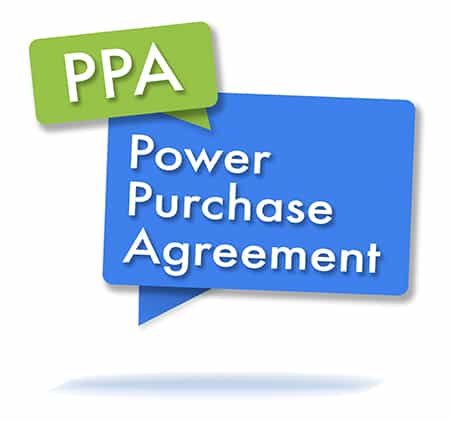Solar power is an excellent concept in theory, but it can be difficult to implement in practice. It’s especially hard on people new to solar.
Some problems include:
- Money. Even though a solar energy system qualifies you for a generous tax credit, financing solar electricity is still tricky.
- Expertise. You need the right knowledge to maintain a solar system (also known as a photovoltaic system). Most people haven’t gone to school to become electricians, let alone solar installers. Almost all PV system installation has to be done by a solar company, which can increase costs.

The Green Movement has adopted the Solar Power Purchase Agreement (SPPA or PPA) to solve these problems and help consumers meet their renewable energy goals.
So, what is a PPA?
A power purchase agreement (or PPA) is an incentive to help manufacturers and new solar buyers pay for a solar panel system. Learn about this important legal document, how it works, and who can qualify for it. After reading this Standard Power Purchase Agreement Guide, we hope you will better understand how this renewable energy agreement works. By creating sustainable electricity legal agreements, homeowners can gain more control over their sustainable energy investment.
Energy Runs World
Electricity provides energy, heat, and power to run homes, businesses, and governments. Energy is essential and electrical demand will continue to increase as our technology connects us even more.
To satisfy this increasing demand, power companies must find new sources (besides new water dams or nuclear plants). Utilities have decided to hook their wagon to the Green Energy Movement to create sustainable energy.
PPAs are a new financing option to help those interested in solar power. The PPA lowers the bar so homeowners can enter the solar generation market. Solar PPAs also help solar equipment technicians and power plants by increasing their renewable energy supply.
PPAs Solve Problems
The first wave of the Green Movement encouraged first adopters to place solar panels on their rooftops. They received tremendous energy savings and tax incentives for doing so. But some were more hesitant to adopt this new technology, even with an incentive.
Unfortunately, many photovoltaic systems are very complicated. For a while, only rocket scientists, professors, and engineers seemed to understand how they work. Solar systems require a great deal of scientific expertise for installation, maintenance, and repairs. And the cost proved to be very high. It was difficult to justify the set-up costs because a solar project took many years to enjoy a significant Return on Investment (ROI).
Furthermore, utility companies need to adequately predict energy supply for the future. Many solar equipment manufacturers had unused capacity, making solar installation an unreliable business. The solar industry needed a jump start. Fortunately, power purchase agreements have solved all these problems.
Now, the solar lease phase enables homeowners and third-party investors to cooperate to generate solar energy. The long-term agreement provides utilities with a way to predict future energy supply.
Different Types of Purchase Agreements
It is important to note that many types of future power purchase contracts involve different parties, terms, and conditions. Each will attempt to make solar energy investment more sustainable and profitable. For our purposes, we will focus on three parties to the agreement: 1. Homeowner, 2. Power Company and 3. Solar Equipment Provider (which includes Investors and Service Technicians).
The benefits offered by PPAs include:
1. Homeowner Benefits
Solar homes bring tons of benefits. Homeowners gain energy independence and can enjoy higher property values as a result.
These are just a few of the ways that homeowners benefit from a solar PPA contracts:
- Scientific expertise
- Generate energy
- Save money on your electric bill
- Solar financing
- Increase property value
- Emergency clean energy resource
Most people don’t know how to fix photovoltaic systems.
Solar-equipped homes generate electricity.
Households save money on energy bills by producing a portion of the energy they use.
The best power purchase agreement provides solar financing. Some third-party solar investors are willing to provide zero-cost solar systems in exchange for ownership of the energy produced.
Solar equipment increases property values.
During emergencies, homeowners can tap into their own stored energy. This could be a life-saver.
2. Power Company Benefits
Utility companies benefit from establishing energy sources. The more stable the supply infrastructure, the more likely investors are to grow their ventures.
Here are power company benefits from a power purchase agreement:
- Increase Supply
- Long-Term Agreement
In 2000, the State of California had an energy crisis due to high energy usage. Power companies appreciate the addition of new suppliers, which helps prevent shortages.
Utilities can control power purchase agreement rates, adding more suppliers when necessary. The longer-term agreement assists with rationing, allocation, and budgeting.
3. Third Party Solar Investor Benefits
The solar industry needs a jump start, and these renewable energy contracts provide the following benefits to any energy buyer:
- Lease equipment
- Share profits
- Tax incentives
Investors can reinstall unused solar panels to recuperate costs. And workers can maintain and repair the solar equipment to remain busy.
Third-party investors earn profits by producing energy, which is resold to homeowners, businesses, and utilities. And on top of that, third-party solar investors pick up tax incentives along the way, including the federal tax credit.
Good Candidates for Energy Purchase Agreement
Many power purchase agreements are compromises for those interested in solar energy, but who aren’t 100% ready yet. They might be hesitant due to high upfront costs or equipment maintenance. These virtual power purchase agreements are also more valuable for those with high energy bills already.
Rural Western states, especially Arizona, California, Colorado, and Montana, might be the best locations for rooftop solar systems. With these contracts, the solar provider/solar manufacturer receives tax incentives. All in all, this solar lease is a shared risk investment suitable for those with medium risk tolerance.
How to Construct Power Agreement
You might want to write down your present utility costs and space available for the solar lease. Determine how much you would want to reduce your monthly energy cost. Then, estimate your solar investment risk tolerance.
Third-party investors or utilities will charge you lower power purchase agreement rates. The normal time range is between 10 and 25 years for this solar power purchase agreement. Homeowners are leasing their rooftops to third parties, who will provide installation, maintenance, and service (the third party owns the energy produced).
Energy production is also closely regulated by each state. Therefore, you will need to check with your state to determine its regulations and allowances. Some states are very supportive of PPAs, and even offer their own solar power tax incentives.
Control Risk with Contracts
Solar power purchase agreements can be used by homeowners, power plants, and third parties to control investment risk. Homeowners have more options in determining the terms of installation, maintenance, and sale of energy. Power plants have a long-term agreement providing supply, and solar investors gain tax incentives.
The virtual power purchase agreement is best for rural landowners with high utility bills in the West (who have more sunny days). The second wave of the Green Movement has arrived. These contracts aim to make sustainable energy production the standard for a renewable future.
